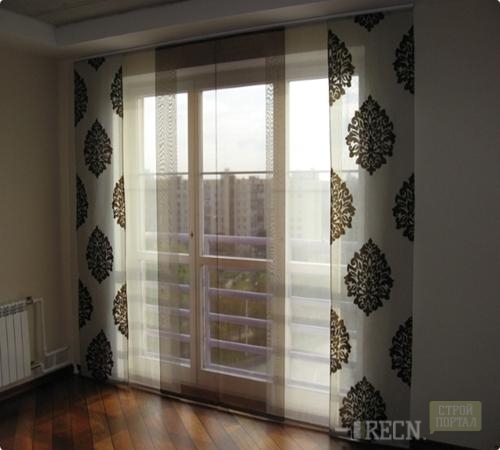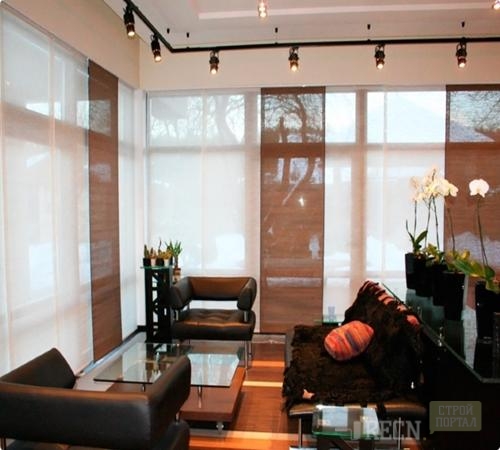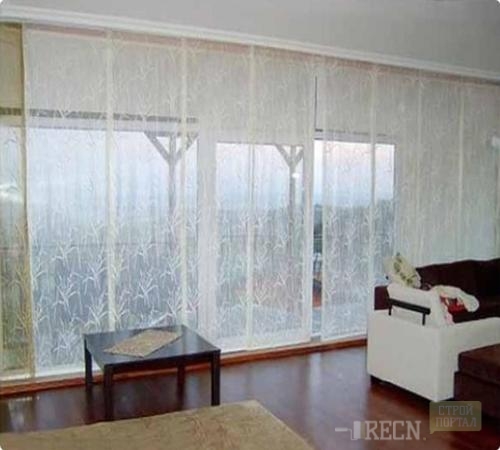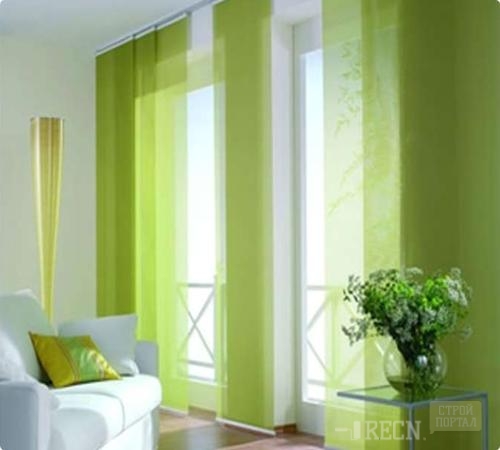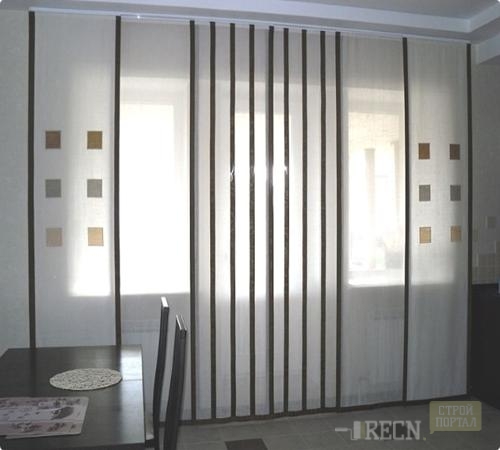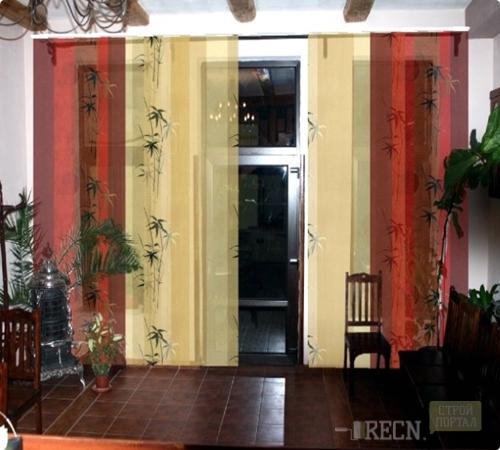
Japanese curtains in the interior Interior items
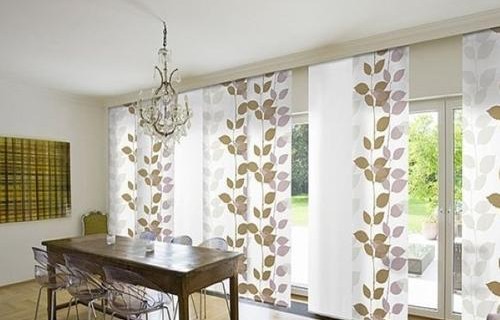
Recently, Japanese, High-Tech, minimalist style design styles, the main highlight and the bright component of which are Japanese curtains are very popular.
Content
What is Japanese curtains
For Japanese curtains, ethnic attributes are characteristic. They can be decorated with a bright, fiery ornament, representing a traditional folk style, or just have a warm and pleasant monophonic color.
This type of curtain, though it has a pronounced focus in design, perfectly combined with the decoration of modern premises, gives it originality and extravagance.
Japanese-style curtains are very light, translucent, air, are movable fabric panels stretched into a special frame-frame. They move along rails, the design of which is similar to the design of the mechanism used for sliding doors. With Japanese panel curtains, low furniture will be best combined without unnecessary elements - shelves, cabinets, antlesole. They emphasize the minimalist design of the room and protect against direct sunlight, creating a scattered, soft light.
Advantages and disadvantages of Japanese curtains
Japanese curtains whose photos are represented in the article possess a number of indisputable advantages. Among them:
- the ability to choose any cloth, any color, without any restrictions;
- subject to the use of natural tissues in the room there is an eco-friendly atmosphere;
- due to the lack of folds and drapes, dust does not accumulate on the tissue panels;
- ease of use, ease of removal for cleaning or replacement;
- no difficult care is required;
- it is very easy to install the cornice and sew the curtains themselves.
The only feature that can be considered a disadvantage is a small selection of forms, because Eastern style provides only a square or rectangle.
Areas of use of Japanese curtains
1. This type of curtain is ideal for spacious rooms and large windows. In addition, they are very beautifully drawn up showcases and various niches.
2. Very good Japanese curtains for the kitchen. They are suitable for most kitchen interiors.
3. Japanese curtains are often used as partitions to separate one room from another. They are very well combined not only with Japanese, but also with avant-garde, minimalist and other modern styles of interior decoration.
4. Also, with the help of Japanese curtains, one room is largely distinguished by several zones of various purposes. In this case, they fulfill the function of a kind of screen.
5. The hosts of the eastern restaurants love to decorate their institutions by Japanese curtains. Very winning they look with panoramic glazing.
6. When decorating an apartment, it is worth experimenting with flowers and drawings. Stitched multicolored canvases look very beautiful. Also, they are often connected by monophonic and bright, colorful fabrics.
What material is used for Japanese curtains and how they are arranged
Clearly designated rules when choosing one or another type of textile for Japanese curtains does not exist. Just if it is decided to combine different tissues, it is necessary to ensure that they are combined with each other. Natural materials such as bamboo, jute, straws look very advantageously.
Japanese-style curtains usually have a bright color and a large drawing. Most often, these are images of birds, hieroglyphs or mythical animals, such as dragons.
To supplement the minimalist interior, it is better to take either a monophonic canvas, or a fabric with a small vegetable or geometric pattern.
Colors and density are selected depending on the preferences of the owner and the overall furnishings of the room. Eastern curtains can be successfully combined both bright, not having any other colors and shades belonging to one color scheme.
From the side of the Japanese curtains resemble vertical blinds with very wide, non-rotating segments. They consist of several bands of tissue fixing on the eaves. Move is carried out by means of a curtain. The cornice itself is fixed anywhere: on the wall, ceiling, niche or doorway. In order for the cloth from the fabric to retain their shape, did not go away and hung smoothly, a small cargo hang to them. If it is necessary to replace or clean the curtains, they can easily be removed from the rails for which they go.
Japanese curtains do it yourself
Japanese curtains to buy will not be difficult, but if desired to save, they are very easy to make them. To do this, it is necessary to choose any fabric, desired color and density. Sometimes there are already ready-made canvas, with a bright pattern for Japan, have been on sale. Required for curtain fittings, such as eaves, runners, are freely available in building stores. It remains only to split the tissue into separate panels of the desired length and width, and consolidate them vertically. The runner design allows you to move the segments of the curtain not only all at the same time, but also separately. With the independent manufacture of the Japanese curtains, it is impossible to forget that they are not combined with any accessories, do not tolerate decorations and not acceptable to collect them in the folds.
The work order looks like this:
1. First of all, it should be calculated which amount of tissue will be required for a particular room. When using a special cornice, the width of the cloth should be 600 mm. If any other mounts were selected, then the size can be any. Divide the width of the window or opening by 600 mm and get the number of cloths going into the joint. If according to the idea of \u200b\u200bthe closure, they must overlap each other, then add another one to this number. The length of them should be equal to the distance from the eaves to the floor, increased by 100 mm for the upper and lower transmission. When all the parameters are set, multiply the curtain length to the number of cloth. The resulting digit will mean the length of the material required for the curtains.
2. The fabric is cut to the strip of the specified width. When you need to take into account the processing of edges and shrinkage.
3. The side points are drained primarily, and the Kulisk is made from below. In order not to spend too much time, it is better to handle all strips at once. For Velcro, the allowance is 10-20 mm.
4. Before you sew a velcro, end it with an iron. After attaching it with pins to the top slice of the cloth and set. Now install it on the wrong side and repeat the operation.
5. Further the panels are carefully stolen. This is very important because the canvas of the Japanese curtains should hang perfectly and form a clear line along the upper and lower face.
6. In the last stage, the crawler in the scene and fix the curtains on the cornice.
As can be seen from the described instructions, the process of creating a curtain in oriental style is extremely simple. Moreover, even if the colors selected for them are not initially combined, when placed in the interior, they can become the original concurrent touch of the entire design of the room. If you still decided to buy ready-made Japanese curtains, their price will depend on the cost of the eaves, as well as the type and quality of fabric. On average, it is 650 and more rubles per sq.m.




